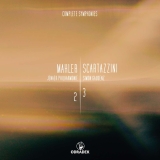In seinem Mahler-Zyklus stellt Simon Gaudenz jeder Symphonie ein kurzes Werk von Andrea Lorenzo Scartazzini voran. So schüren Torso und Epitaph unsere Erwartung auf die Zweite Symphonie, deren ersten Satz Gaudenz anfangs sehr breit und lyrisch angeht, aber mit manchmal schnelleren Tempi verhindert, dass das Ganze nicht zu feierlich wird. Leider wirkt der Satz nicht ganz kohärent und im Tempo doch recht zerfahren. Auch dem zweiten Satz fehlt es an gesundem Atem, und im ziemlich zügig gespielten 3. Satz (In ruhig fließender Bewegung) verpasst Gaudenz so manches, was sein flottes Dirigat konturierter werden lassen könnte. In den Sätzen 4 und 5 funktioniert die Atmung besser, aber Mahlers Anforderungen bringen hier Orchester und vor allem den Chor an ihre Grenzen.
Das mysteriöse, spukhafte Spiriti von Andrea Lorenzo Scartazzini führt zum ersten Satz der Dritten Symphonie. Es gibt zu viele herausragende Interpretationen davon, als dass diese einen begeistern könnte. Das gilt noch mehr für das Menuett und die folgenden, wenig charakteristischen, rhetorisch nicht gut durchgeformten und oft flachen Sätze. Erst im Finale gelingt es mir mich wieder einzuklinken. Simon Gaudenz gestaltet diesen Satz sehr inspiriert und schafft eine schöne Stimmung, völlig natürlich, ohne jeden Exzess. Der letzte Satz wird so stimmungsvoll und von großer, erhabener, ja ergreifender und hymnischer Ruhe.
Aufs Ganze gesehen kann diese Aufnahme natürlich nicht mit Abbado, Rattle, Chailly oder Tilson Thomas konkurrieren.
In his Mahler cycle, Simon Gaudenz precedes each symphony with a short work by Andrea Lorenzo Scartazzini. Torso and Epitaph thus fuel our anticipation of the Second Symphony, the first movement of which Gaudenz approaches very broadly and lyrically at the beginning, but with sometimes faster tempi he prevents the music from becoming too solemn. Unfortunately, the movement is not entirely coherent and the tempo is rather disjointed. The second movement also lacks a healthy breath, and in the rather briskly played 3rd movement (In ruhig fließender Bewegung), Gaudenz misses a few things that could have given his brisk conducting more contour. The breathing works better in movements 4 and 5, but Mahler’s demands here push the orchestra and especially the choir to their limits.
The mysterious, spooky Spiriti by Andrea Lorenzo Scartazzini leads to the first movement of the Third Symphony. There are too many outstanding interpretations of it for this one to inspire. This applies even more to the minuet and the following movements, which are uncharacteristic, rhetorically unformed and often flat. Only in the finale do I manage to get back into the music. Simon Gaudenz shapes this movement in a very inspired way and creates a beautiful mood, completely natural, without any excess. The last movement is so atmospheric and of great, sublime, even poignant and hymn-like calm.
On the whole, of course, this recording cannot compete with Abbado, Rattle, Chailly or Tilson Thomas.






















